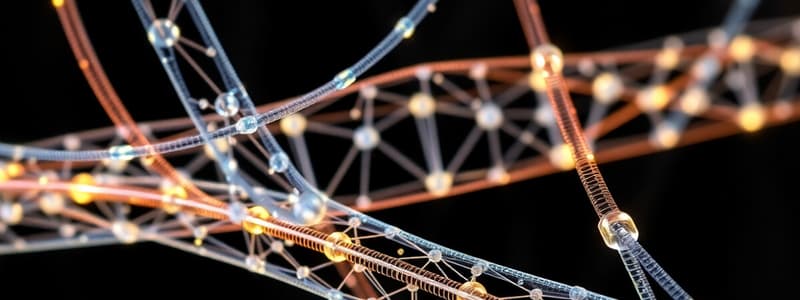Podcast
Questions and Answers
What does Castigliano's Second Theorem help to calculate in elastic structures?
What does Castigliano's Second Theorem help to calculate in elastic structures?
- Strain energy directly
- Reactions at supports
- Displacement due to external load (correct)
- Internal forces only
Which equation correctly represents the displacement in Castigliano's Second Theorem?
Which equation correctly represents the displacement in Castigliano's Second Theorem?
- $ rac{ ext{d}U}{ ext{d}P}$ (correct)
- $ rac{ ext{d}U}{ ext{d}x}$
- $ rac{ ext{d}P}{ ext{d}U}$
- $ rac{ ext{d}U}{ ext{d}t}$
What must the external work done on a system equal, according to the Principle of Least Work?
What must the external work done on a system equal, according to the Principle of Least Work?
- The change in internal energy (correct)
- The total load applied
- The sum of internal forces
- The change in strain energy only
How do you determine the degree of redundancy in a frame?
How do you determine the degree of redundancy in a frame?
What is the first step in the analysis of redundant frames?
What is the first step in the analysis of redundant frames?
In the context of bending for a member, which formula accurately expresses strain energy?
In the context of bending for a member, which formula accurately expresses strain energy?
When analyzing redundant structures, what must be done after computing the displacements?
When analyzing redundant structures, what must be done after computing the displacements?
What is a defining characteristic of a truss structure?
What is a defining characteristic of a truss structure?
Which method is primarily used to calculate support reactions and internal forces in non-redundant members?
Which method is primarily used to calculate support reactions and internal forces in non-redundant members?
What is the primary focus of the analysis of redundant members in a truss?
What is the primary focus of the analysis of redundant members in a truss?
Which step involves calculating reactions and internal forces in non-redundant members using equilibrium equations?
Which step involves calculating reactions and internal forces in non-redundant members using equilibrium equations?
In the formula for strain energy, which variable represents the axial force in a member?
In the formula for strain energy, which variable represents the axial force in a member?
What is the purpose of applying Castigliano’s Theorem in truss analysis?
What is the purpose of applying Castigliano’s Theorem in truss analysis?
What does the term 'degree of redundancy' refer to in truss analysis?
What does the term 'degree of redundancy' refer to in truss analysis?
When calculating strain energy, which of the following parameters does NOT affect the energy computed?
When calculating strain energy, which of the following parameters does NOT affect the energy computed?
At what point can engineers effectively determine internal forces in trusses?
At what point can engineers effectively determine internal forces in trusses?
Why is understanding redundancy important in structural design?
Why is understanding redundancy important in structural design?
What method is emphasized for analyzing redundant frames and trusses in Unit III?
What method is emphasized for analyzing redundant frames and trusses in Unit III?
What will result if redundant members are incorrectly identified in a truss?
What will result if redundant members are incorrectly identified in a truss?
Flashcards
Castigliano's Second Theorem
Castigliano's Second Theorem
Calculates displacement in elastic structures due to external loads.
Displacement Equation
Displacement Equation
$\frac{\text{d}U}{\text{d}P}$, where U is strain energy and P is external load.
Principle of Least Work
Principle of Least Work
The external work equals the change in internal energy.
Degree of Redundancy
Degree of Redundancy
Signup and view all the flashcards
Analyzing Redundant Frames: Step 1
Analyzing Redundant Frames: Step 1
Signup and view all the flashcards
Strain Energy Formula (Bending)
Strain Energy Formula (Bending)
Signup and view all the flashcards
After Computing Displacements
After Computing Displacements
Signup and view all the flashcards
Truss Structure
Truss Structure
Signup and view all the flashcards
Non-Redundant Member Analysis
Non-Redundant Member Analysis
Signup and view all the flashcards
Redundant Member Analysis
Redundant Member Analysis
Signup and view all the flashcards
Static Equilibrium (Step)
Static Equilibrium (Step)
Signup and view all the flashcards
$N_i$
$N_i$
Signup and view all the flashcards
Purpose of Castigliano’s Theorem
Purpose of Castigliano’s Theorem
Signup and view all the flashcards
Degree of Redundancy (Truss)
Degree of Redundancy (Truss)
Signup and view all the flashcards
Unaffacted Parameter in Strain Energy
Unaffacted Parameter in Strain Energy
Signup and view all the flashcards
Determining Internal Forces in Trusses
Determining Internal Forces in Trusses
Signup and view all the flashcards
Importance of Understanding Redundancy
Importance of Understanding Redundancy
Signup and view all the flashcards
Redundant Frame/Truss Analysis Method
Redundant Frame/Truss Analysis Method
Signup and view all the flashcards
Result of Misidentifying Redundant Members
Result of Misidentifying Redundant Members
Signup and view all the flashcards
Study Notes
Castigliano's Second Theorem
- Powerful method for finding displacements in elastic structures
- Based on the concept of strain energy
- Formula: ( \delta = \frac{\partial U}{\partial P} )
- ( \delta ) is the displacement
- ( U ) is the strain energy
- ( P ) is the external load
Principle of Least Work
- Basis for energy methods in structural analysis
- External work done on a system equals the change in its internal energy
Analysis of Redundant Frames (Up to Two Degrees of Redundancy)
- Identifying Redundancies: Determine the number of members exceeding the minimum required for equilibrium
- Calculate Reactions and Internal Forces: Use conventional methods for non-redundant members
- Compute Strain Energy: Calculate total strain energy using formulas
- Bending: ( U = \frac{1}{2} \int M^2 , \frac{dx}{EI} )
- Axial Loads: ( U = \frac{1}{2} \int N^2 , \frac{dx}{EA} )
- Apply Castigliano's Theorem: Differentiate strain energy with respect to the redundant force to find displacement at the point of redundancy
- Solve the Equations: Set up equations based on calculated displacements and solve for redundant forces
Analysis of Redundant Trusses (Up to Second Degree of Redundancy)
- Truss Structure: Composed of members joined at the ends, designed to support loads through axial forces
- Redundant Members: More members than required for structural stability
- Identify Redundant Members: Determine redundant members and overall redundancy
- Static Equilibrium: Analyze using equilibrium equations for non-redundant members
- Compute Strain Energy: Similar to frames, using the formula: ( U = \frac{1}{2} \sum \frac{N_i^2 L_i}{A_i E_i} )
- Apply Castigliano's Theorem: Differentiate strain energy with respect to redundant force for displacement relationship
- Solve for Redundant Forces: Set up equations based on equilibrium and displacements to find redundant forces
Studying That Suits You
Use AI to generate personalized quizzes and flashcards to suit your learning preferences.



